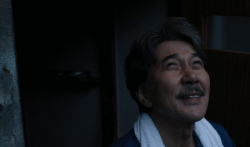As a person who is fairly ignorant of the D.C. art scene, the Chuck Close exhibit opening at the Adamson Gallery left me much more enlightened than one would expect, having seen just one opening, at one gallery, on one Saturday evening.
But on this particular Saturday evening, it seemed that many of the surprising collection of galleries up and down 14th Street had an opening to celebrate. My friend and I inadvertently saw three other openings before we made it to the Adamson.
When you walk into the gallery, the first piece you see is one of Close’s highly celebrated screen prints, a self-portrait composed of tiny blocks of color that, when seen on their own, resemble nothing but a m?lange of color. Seen as a whole, however, the blocks of color work together to form a large head shot of Close himself.
As you turn into the main room, Close’s daguerreotypes of seemingly unknown personalities line the wall to your right. At a certain angle you can see your own image in the frame. If you look down at the image where it is shadowed by a carefully placed piece of painted wood, however, the three-dimensional faces of Close’s subjects emerge. Their faces are overexposed and rough, and the medium makes them interestingly eerie.
Close’s series of pigment prints of Kate Moss is the most exciting of his work on display. These images, previously printed in W magazine, show Kate in a very different light from her magazine covers. Her skin looks tarnished, much like the subjects of Close’s daguerreotypes, with her freckles exaggerated. Her pores look like large, open wounds.
You might think that Kate, one of the most coveted models of our time, appears less desirable in these images. However, Close manages to capture in this series that beauty present in all of us: imperfection. These prints make you feel that Kate’s and your flaws are acceptable at the very least.
The Close exhibit is itself a remarkable showing of his work, but it seems out of place at a small gallery in D.C.
David Adamson, founder of the gallery and of Adamson Editions, a printing atelier here in D.C., was the first to introduce digital printing to the art world in 1996. His first prospective customer, Chuck Close, fell in love with Adamson’s prints, and since then throes of artists have followed suit.
Several of the Lee Friedlander portraits currently on display at the Museum of Modern Art in New York are Adamson prints. He has also courted artists such as Robert Rauschenberg, Annie Leibovitz and Lou Reed, to name a few.
When asked why he works out of D.C. when the majority of his clients are based in New York, Adamson responded that many of his artists like having a break from the hustle and bustle of the art world in New York City. Both the Close exhibit and the larger 14th Street art scene are very unassuming. They are welcoming to those who are not as hooked into the art world as they might like to be.




